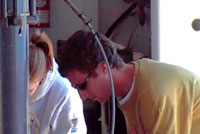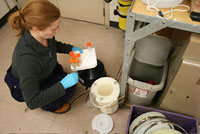

 | |||||||||||||||||||
|
|
Journals 2008/2009Jeff Lawrence
December 29, 2008
Dan Schuller is an employee with Scripps Ocean Institute out of San Diego. Dan is on board the REVELLE via request of Dr. Balch to help with the research on coccolithophores. Dan is the first person to sample the water. He samples for oxygen, nutrients and salts. Scripps provides people onboard their research vessels for scientists to use in their research while aboard the REVELLE. Dan is one of several on board the REVELLE that have been added to the regular crew to help perform some of the science protocols that will be useful for Dr. Balch and fellow scientists. Scripps Ocean Institute is one of the world's oldest, established, and well-respected centers for ocean research. Scripps has outreach programs for educating the public to the importance of our earth's oceans. Scripps began around 1903 when newspaper tycoon E.W. Scripps joined forces with several others including zoologists William E. Ritter to perform biological and hydrographic surveys of Southern California's coastal region. Shortly after Scripps Institute was established and has been conducting ocean research around the world for more than a century. For more information you can look at the Scripps website: http://sio.ucsd.edu/img/timeline/.
Laura Daniels is with the British delegation and is quick freezing samples collected from the SAPS unit so that the proteins won't break down. SAPS, is the underwater filtering system covered in an earlier journal entry. If you put the samples in a regular freezer, by the time they are frozen the protein structure could change somewhat losing the original structure. So the samples are placed in plastic tubes and dipped into liquid nitrogen so they can be sampled later back at the lab in South Hampton, England. The British delegation is from the University of South Hampton's National Oceanography Center. They have been working hard to gather samples to store in liquid nitrogen to be taken to the UK for further analysis. The Brits have been very hospitable to me while on board. They have allowed me to help them with the SAPS unit and watch them work while answering all my questions about their research. I appreciate their help and permission to tag along and at times help them. Questions of the Day:
|
||||||||||||||||||



